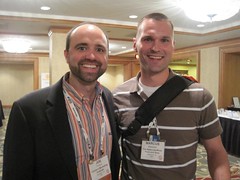Speaking about Value – research tidbits
Some recent articles on value, pricing and sales came across my desk last week.
You”re pricing it wrong from SmashingMagazine . You’re pricing it wrong is by Fran Galperin. He presents some very compelling arguments making this a useful read for all. I I picked up on two definitions of value he used, Perceived and Objective value. In his words, “You can set a higher price without changing your product just by changing the potential customer’s perception of the product.” Objective value is how much would people pay if they were indeed rational decision-making machines. “
He believes that buyers are not logical, rationale decision makers, but are much more emotional about decisions, giving the perceived value more importance in a sale. “Vendors can improve the perceived value through marketing with such things as copy, visual design, and demos.” In our research we have seen how marketing has just such an impact on presetting the reference price of a product and contributes to the the retention (or loss) of value through the sales process.
The Sales Lead Black Hole ( download) from Penn State Business school – marketing is a scholarly analysis of why 70% of marketing’s leads are not followed up by the sales team. It is good research and could be one of a kind in this area. In the summary they say,”
“We find that sales reps spend more time pursuing marketing leads if they
perceive their firm has an effective sales lead prequalification process.
We also find that as sales reps become more experienced, they are less likely to:
- pursue marketing-generated leads,
- respond positively to managerial tracking of marketing lead follow-up, or
- respond positively to greater marketing-generated lead volume.
Our results also show that the better the sales reps’ past performance, the more likely they are to respond positively to
an increase in volume of marketing-generated leads and respond negatively to managerial tracking of marketing lead follow-up.”
This is material that gives good directions for how sales managers can make a greater impact on the team performance. It is academic but is very direct in application and well worth the read.
Exploring Price Fairness Perceptions in China and U.S. by Lisa Bolton, associate professor of marketing at Penn State’s Smeal College of Business, along with Hean Tat Keh from Peking University and Joseph W. Alba from the University of Florida, Pennsylvania State Business School. Fascinating bit of research. E.g.
- Bolton, et al find that both Chinese and American consumers judge it fair to pay a lower price but unfair to pay a higher price than paid by another customer. In other words, “what’s good for me is fair”—a kind of egocentric bias at work. However, the Chinese are especially sensitive to the type of comparison. For example, Chinese consumers judge it unfair to pay a higher price than a friend but are indifferent to the price paid by a stranger. In contrast, Americans are indifferent to the friend-stranger distinction, judging it equally unfair to pay a higher price than paid by either a friend or a stranger.
- These findings reflect the tendency of Western cultures to possess an independent, individualistic identity, whereas Eastern cultures are interdependent or collectivist in nature. Bolton says the Chinese “view the world as a network of social relationships and are, as a result, strongly oriented toward the in-group (friends and loyal relationships).” In contrast, Americans see the world in terms of independent and autonomous individuals and are less sensitive to relational information. For example, prior research shows that Americans perceive friends, coworkers, and business owners as equivalents, but such is not the case for the Chinese, who put greater emphasis on their personal social networks.
- Another concept that comes into play in the research conducted by Bolton and her colleagues is a culture’s sensitivity to mianzi or “face.” Face is defined as status earned in a social network, and a person can either gain or lose face depending on the situation. Keeping in mind the difference between the collectivist Chinese consumer and the individualist American consumer, Chinese consumers typically experience a greater loss of face if they pay a higher price than a person in their in-group as opposed to someone in an out-group. For example, paying a higher price than a friend affects the Chinese consumer’s status or “face” within the social network and is experienced as a feeling of shame. In contrast, the American consumer tends to feel anger at paying a higher price than another consumer, friend, or stranger.
- Ultimately, consumer price fairness response and emotional reactions affect customers’ interactions with the firm in regards to purchase intent. For example, American consumers report lower intentions to re-purchase after paying a higher price than another consumer, whether friend or stranger. Chinese consumers are less likely to re-purchase after paying a higher price than a friend, but are unaffected by what a stranger paid.
- Interestingly, the cultural differences in sensitivity to relationships among consumers also extend to relationships between consumers and firms. The researchers find that “Chinese consumers judge it unfair to pay a higher price than another customer when in a loyal relationship with a firm but are relatively indifferent when in a first-time buyer situation. In contrast, Americans judge paying a higher price than another customer as unfair regardless of past loyalty to the firm.” Again, the results appear to be driven by face: Chinese consumers experience a greater loss of face when they pay a higher price to a vendor with whom they have a long relationship as opposed to a new vendor.
These findings by Bolton and her colleagues suggest that price perceptions are more a matter of psychology than economics—with many implications for marketers, particularly in the areas of dynamic pricing and relationship marketing. If consumers feel that dynamic pricing is unfair, marketers can defend themselves against consumer backlash by using differentiation to reduce the impact of the price comparison. Doing so may be especially important with American consumers, who will resist paying a higher price regardless of the identity of the other consumer.
In terms of relationship marketing, conventional wisdom states that loyal consumers are less price sensitive, so they’re willing to pay a higher price. According to Bolton, “Our research suggests that, if anything, loyal consumers are more price sensitive.” Americans are equally sensitive regardless of whether they’re loyal or first-time buyers, and Chinese consumers are more price sensitive when loyal. As a result, marketers need to take into account the importance of culture, and the role of social networks and personal relationships, in order to effectively market their products in the United States and China.

Day 1. A Kindle Fire in Canada
First impressions. Lovely to look at, nice to hold and a bit heavier than earlier Kindles
Books etc all delivered flawlessly.Everything the other Kindles do this does.
Added pdf docs from my pc. Worked well, colour. Yeh!
Browser is an improvement. Will not win speed awards.
Colour sucks more juice so you will need to charge it more often.
The early adopter penalty is that the “tablet” stuff is not available in Canada until they get legal stuff sorted out .
Eg.
I pushed music up to to the Amazon cloud for my pc (Had to use Hotspot as they have not turned the cloud on for Canada). Music was then pushed down to the Kindle – works well
Getting new Android apps is a can not do if you are not connected in the US. Not cleared for anywhere else yet. So Apple wins until that happens since their Cloud and store worked asap.
Hotspot to my pc would not work for apps as Amazon checks where the device is connected and will not let you download. I could root the unit…
The apps that come with the Kindle.
Mail app worked with Gmail – looks good.
Pandora, not in Canada.Quickoffice app reads office attachments.
Pulse app aggregates lots of blog feeds. Pretty good. Add your magazine feeds here.
If you connect via wifi in the us, you can get everything. The app then works in Canada.
Ditto for streaming video. Not in Canada. I tried to add a video I had to the device from my pc. Could not find it.
Magazines. Only allowed to send B&W in Canada as yet. This will come. Need a US address for colour.
So no advantage to getting this early. But I expect it will all get done.
Related articles
- Kindle Fire: Non-techie perspective (zdnet.com)
- Can Nook Coloured Tablet Beat Kindle Fire? (blogs.vinuthomas.com)
- The Tech-pert: Is the Kindle Fire the Best Tablet Computer for Under $200? (savings.com)
- Amazon to sell 12 million Kindle Fire units next year – analyst (intomobile.com)
- Nook Tablet and Kindle Fire: Best tablets in their price range (news.consumerreports.org)
- Kindle Fire vs iPad: How to decide (tuaw.com)
- Kindle Fire Review: 5 Things Amazon’s New Tablet Is Missing (dailyfinance.com)

Category: Technology Industry
Rusher’s Gap and its implications on price discounting.
Rusher’s Gap and its implications on pricing. (Thanks to David Moulton for pointing this out to me.) Rusher’s Gap is named for the former magazine publisher William Rusher. Rusher’s Gap is the difference between the extra amount you figured something would cost and what it actually did cost. Here is an example common today in software sales.
One of the unplanned outcomes of the hey days of big , costly ERP software implementations is that savvy CFOs and procurement officers who have gone through the process now believe that if the software is quoted at say $350 000, the true cost of deploying, and implementing it will be another $350 000, a Rusher’s gap. making the total is twice as much. Thus sometimes when buyers receive quotes for software now, they do not believe the number but automatically double the amount, causing them to push back. As Bob Artner says on TechRepublic, this is different from sticker shock . The price oriented salesperson goes back to his manager and negotiates a hefty $50 000 discount (14%). The purchaser sees a $ new quote for $300 000 and in his mind makes that a $600 000 total purchase.
Artner goes on to say”
Rather than spending your time defending the cost you quoted or speculating how you can save money at the margins by cutting out features, what you need to do is convince the would-be client that the number you quoted, no matter how high, isn’t going to go significantly higher. In other words, instead of trying to defend x, you need to explain why it’s going to cost x, and not 1.4*x, and then some.
How do you do that? Well, here are some suggestions (and there are plenty more):
-
- Make sure that your numbers are right before you walk into the room.
- Provide milestones on the project path that break down the expenses by project phase.
- Perhaps most importantly, provide references that can attest to your firm’s ability to accurately forecast project costs.
Thus if a sales force is working from a value based pricing model, when faced with what could be a Rushers’ Gap, they need to be prepared with the above proof and activities. Better yet, the value based pricing model includes a response to Rushers Gap. For any selling organization, on budget execution after the sale is paramount to providing proof needed in the next presale in order to get to the value based pricing.

Room for All of Us. Adrienne Clarkson
Room for All of Us. Adrienne Clarkson. 2011. ISBN 9780670065479. The idea of this book is to chronicle representatives of immigrant groups who came to Canada to have a better life. Its a good idea. Too bad there was not enough room for the idea and Clarkson in the same book. Very disappointing since I do not want to read any more about her, but I did want to learn about the immigrant groups. Well at least she did not disappoint, based on past performances. What is it that she can not say my husband” but always has to use his name. Who cares? Easy read, good pace, just needed some ego editing. Borrow it from a friend if you must read it.
Related articles
- The voice of the new (macleans.ca)

Category: Travel
The Golden Spruce. A true story of myth, madness and greed. John Vaillant.
The Golden Spruce. A true story of myth, madness and greed. John Vaillant. 2005. A Governor Generals award winning book about a man possessed who cut down a 400 yr. old tree sacred to the Haida in the Queen Charlotte‘s. The book combines a story about the BC forest industry, overlaid with Haida culture and meshed with the life of one man Grant Hadwin. It is a descriptive and mystical journey that gives a sensitive view of how all these elements collided and why this destruction happened. I felt close to this story, havinig spent some time on the Charlottes, seen the Golden Spruce, visited many of the places in the book and met several of the characters described. A bit slow, the book is still a good read and it is well written.

Category: Travel
Managing Content Marketing. The real world guide for creating passionate subscribers to your brand. Robert Rose & Joe Pulizzi.
Managing Content Marketing. The real world guide for creating passionate subscribers to your brand. Robert Rose & Joe Pulizzi. 2011. ISBN 9780983330714. Pulizzi is the Godfather of Content Marketing – we used his book Get Content Get Customers in our Content Marketing Program. This book is the business extension of doing the content marketing work in your company. The authors never forget that it is the buyers view point and journey that is important, not your sales process. It does a very good job and is a valuable addition to the growing body of work on Content Marketing. I especially enjoy the very readable concise style of this book as the authors recognize that the reader wants to get right to the job at hand. Their chapter on marketing ROI is likely the best documentation out there at the moment. This is must have book for all marketers. Those who chose not to adapt, choose to fail.
Related articles
- Content Marketing Pioneer and Entrepreneur Joe Pulizzi, First to Join 9Threads’ Board of Advisors (prweb.com)
- How Far Should You Open the Content Kimono? (blogworld.com)
- 5 Reasons Why Your Content Marketing Strategy Fails (searchmarketingstandard.com)
- Content Marketing: Publishing is the New Marketing – Free webcast at Search Marketing Now, May 18 (prweb.com)
- 5 Key Roles for Content Marketing Success in 2012 (toprankblog.com)
- Small Business Content Marketing Gold (growmap.com)
- Marketing vs. Publishing: Both Create Content, Drive Leads (hubspot.com)
- Grande Guide to B2B Content Marketing (cc-chapman.com)
- How to fast-track your career with content marketing (thecontentlab.icrossing.com)
- Content marketing playbook (drewsmarketingminute.com)

Category: Content Marketing, Marketing
Oh Google Reader – you have really screwed up my day
Google Reader warned us it was changing and we would loose the shared feed option. No matter, the loss is so much worse than I expected.
No longer:
- Can I easily find and sent out relevant info daily to my audience on content marketing and sales
- Can I easily read the items as quickly in Reader.
- Can i post “found items on the Web through Reader – keeping track of everything in one place.
Google – you hurt me personally by stopping Google Health – an absolutely elegant idea of health records in the cloud.
But now the loss of reader as a shared item ( forget the use of G+ to replace it – its a different tool) impacts my publishing.
I spent five hours yesterday trying to replace the item – and found the solutions inadequate. You have killed my ability to curate on the larger scale. Damn you!!!!
Related articles
- Google Degrades Its Reader (delong.typepad.com)
- Google neuters Google Reader (e1evation.com)
- Serious Problem with the New Google Reader (ask.metafilter.com)
- Google Reader Ditches Sharing in Redesign (linearfix.wordpress.com)
- Did Google break the most important site on the web? (arhg.net)
- Google Reader Diaspora (ask.metafilter.com)

Category: Marketing










